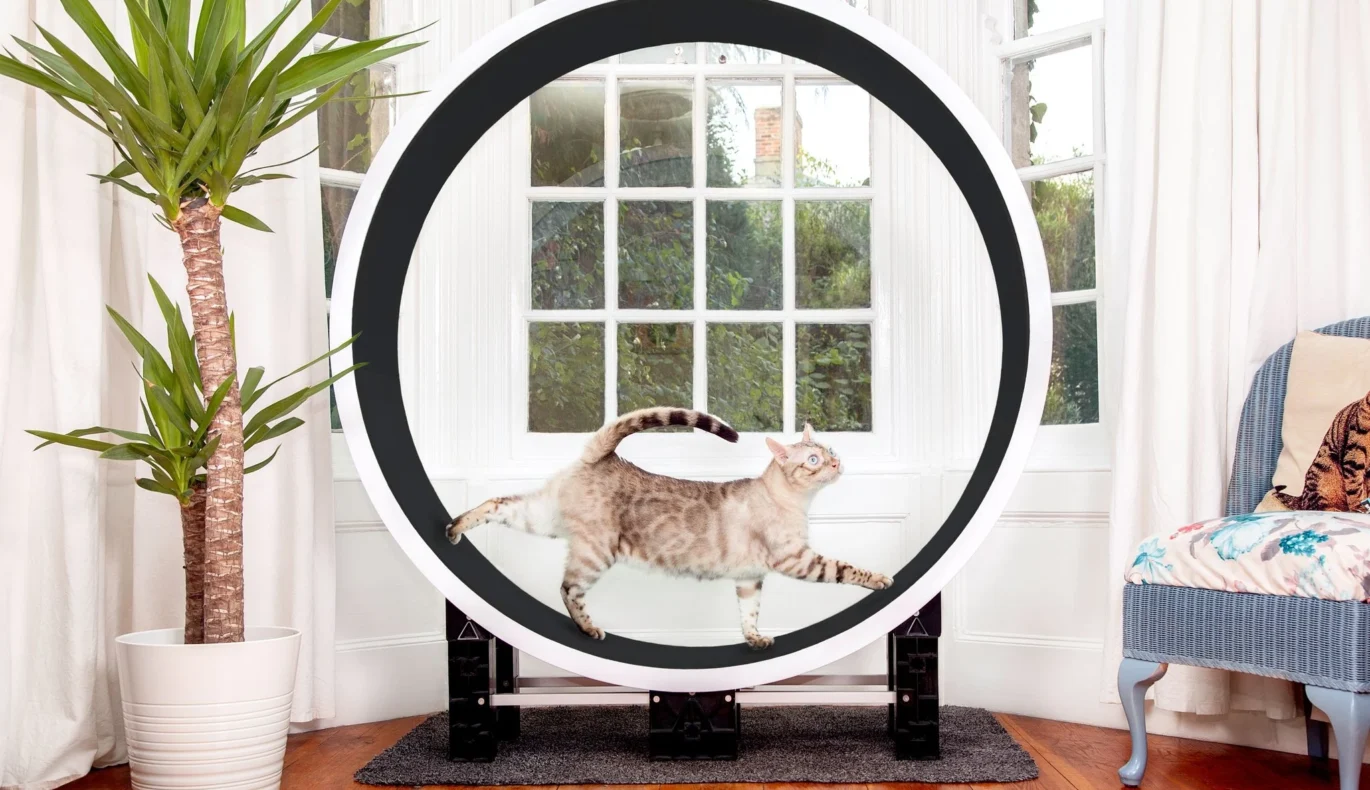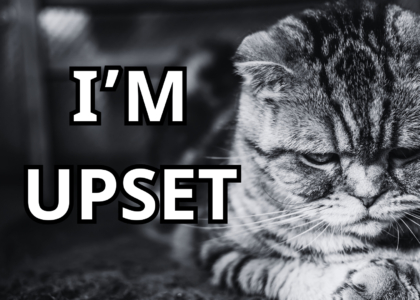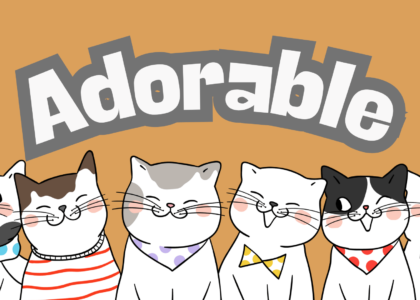I. Introduction
Cat exercise wheels have gained immense popularity in recent years, providing indoor cats with a fun and engaging way to stay active. Much like their smaller counterpart, the hamster wheel, these oversized contraptions are designed to cater to a cat’s natural need for exercise, especially for indoor pets that might lack opportunities to roam freely.
However, as functional and beneficial as these wheels are, one concern often voiced by pet owners is the level of noise they produce. After all, no one wants their peaceful evenings disrupted by a clunky, squeaky wheel or a vigorous feline workout session in the middle of the night. The noise level of a cat exercise wheel can be a deciding factor for many households, particularly those in apartments or shared living spaces.
In this article, we’ll dive deep into the question: “How noisy is a cat exercise wheel?” We’ll explore the factors that influence noise levels, review popular brands, and provide tips to minimize any disturbances. By the end, you’ll have a comprehensive understanding of how to choose and maintain a cat exercise wheel that balances your cat’s exercise needs with your household’s peace and quiet.
II. Understanding Cat Exercise Wheels
Cat exercise wheels have revolutionized the way indoor cats stay active, providing an innovative solution for their physical and mental well-being. To fully appreciate their utility, it’s essential to understand what they are, why they’re beneficial, and the common concerns surrounding them.
A. What is a Cat Exercise Wheel?
A cat exercise wheel is a large, rotating device similar to a hamster wheel but specifically designed for cats. These wheels allow cats to walk, jog, or run in place, burning off excess energy and satisfying their natural instincts to hunt, chase, and play. Constructed with sturdy materials to support a cat’s weight and size, the wheel’s curved interior offers a smooth surface that encourages fluid movement.
B. Why Cat Owners Choose Them
Indoor cats often face challenges when it comes to staying active, especially in environments that lack ample space or stimulation. Cat exercise wheels address these challenges by:
- Promoting Physical Health: Regular use helps prevent obesity, maintain muscle tone, and support joint health.
- Providing Mental Stimulation: Running on a wheel mimics the thrill of chasing prey, which keeps cats engaged and reduces boredom.
- Encouraging Natural Behaviors: Cats have a natural urge to run and pounce, and an exercise wheel offers a safe outlet for these instincts.
- Improving Behavioral Issues: High-energy cats may exhibit fewer destructive behaviors, such as scratching furniture or excessive meowing, when they have an outlet to release pent-up energy.
C. Common Concerns of Cat Exercise Wheels
While the benefits are undeniable, potential drawbacks must also be considered. Among these, noise is one of the most commonly mentioned issues. Cat exercise wheels can produce varying levels of sound depending on their construction, placement, and how they’re maintained. Noise becomes particularly relevant for cat owners living in shared spaces, where excessive sound might disturb family members or neighbors.
Other concerns include the wheel’s size and space requirements, the initial cost of purchase, and whether all cats will take to using it. Despite these challenges, the growing popularity of cat exercise wheels indicates their significant value for modern pet owners.
By understanding the purpose and benefits of cat exercise wheels, it’s easier to see why their noise level is a concern worth exploring. In the next section, we’ll delve into how noisy these wheels really are and the factors that influence their sound.
III. How Noisy Are Cat Exercise Wheels?
The noise level of a cat exercise wheel can vary significantly depending on several factors, such as its construction, the environment it’s used in, and how well it’s maintained. For many cat owners, understanding these variables is essential to deciding whether a wheel is suitable for their home.
A. Factors Influencing Noise Levels
Several elements contribute to the overall noise produced by a cat exercise wheel:
- Material:
The material of the wheel plays a significant role in determining its sound output.- Plastic wheels tend to be lightweight but may create a hollow, echoing noise when in use.
- Wooden wheels are generally quieter due to their solid construction, but they can creak over time if not properly maintained.
- Metal wheels, though durable, can be noisier due to vibrations and rattling.
- Design and Engineering:
The design of the wheel affects how smoothly it operates. A well-engineered wheel with high-quality ball bearings will produce less noise compared to a poorly constructed one. Stability is also key—wobbly or imbalanced wheels tend to create additional vibrations and sounds. - Flooring Surface:
The type of floor beneath the wheel significantly impacts noise. On hard surfaces like tile or hardwood, vibrations can amplify, creating more sound. Placing the wheel on a carpet or a noise-dampening mat can reduce these effects. - Bearings and Mechanisms:
Wheels with advanced ball-bearing systems are typically quieter, allowing for smooth, frictionless rotation. On the other hand, friction-based mechanisms can produce squeaking or grinding noises over time. - Wear and Tear:
Over time, even the best wheels can become noisier if they aren’t properly maintained. Dirt and debris buildup, loose screws, or lack of lubrication in the moving parts can all contribute to increased sound.
B. Noise Levels During Different Activities
The noise produced by a cat exercise wheel can also vary depending on how it’s being used:
- Fast Running vs. Slow Jogging:
- When a cat is running at high speeds, the wheel’s movement is often louder due to the force and frequency of rotation.
- During slower jogging or walking, the noise is typically more subdued and rhythmic.
- Cat-Specific Factors:
- Larger or heavier cats may cause more vibration, leading to additional noise.
- Enthusiastic cats that leap onto the wheel with force or use it sporadically can create unpredictable sounds.
C. Common Noise Complaints from Cat Owners
Real-world experiences from cat owners reveal a range of noise-related feedback:
- Some users report a gentle whirring sound, which is easy to tolerate.
- Others mention squeaking or rattling, often attributed to loose parts or wear over time.
- Vibrations traveling through the floor are a frequent concern in apartments or shared living spaces.
Understanding the factors that influence noise levels and how they vary in different scenarios is key to finding a cat exercise wheel that fits your lifestyle. In the next section, we’ll explore how various brands perform in terms of noise and provide tips to minimize disturbances.
IV. Top Brands and Their Noise Levels
When selecting a cat exercise wheel, choosing the right brand can make a significant difference in noise levels, as different manufacturers prioritize materials, design, and engineering quality. Below, we explore some of the top brands in the market, their unique features, and how they perform in terms of noise.
A. Comparison of Popular Cat Exercise Wheels
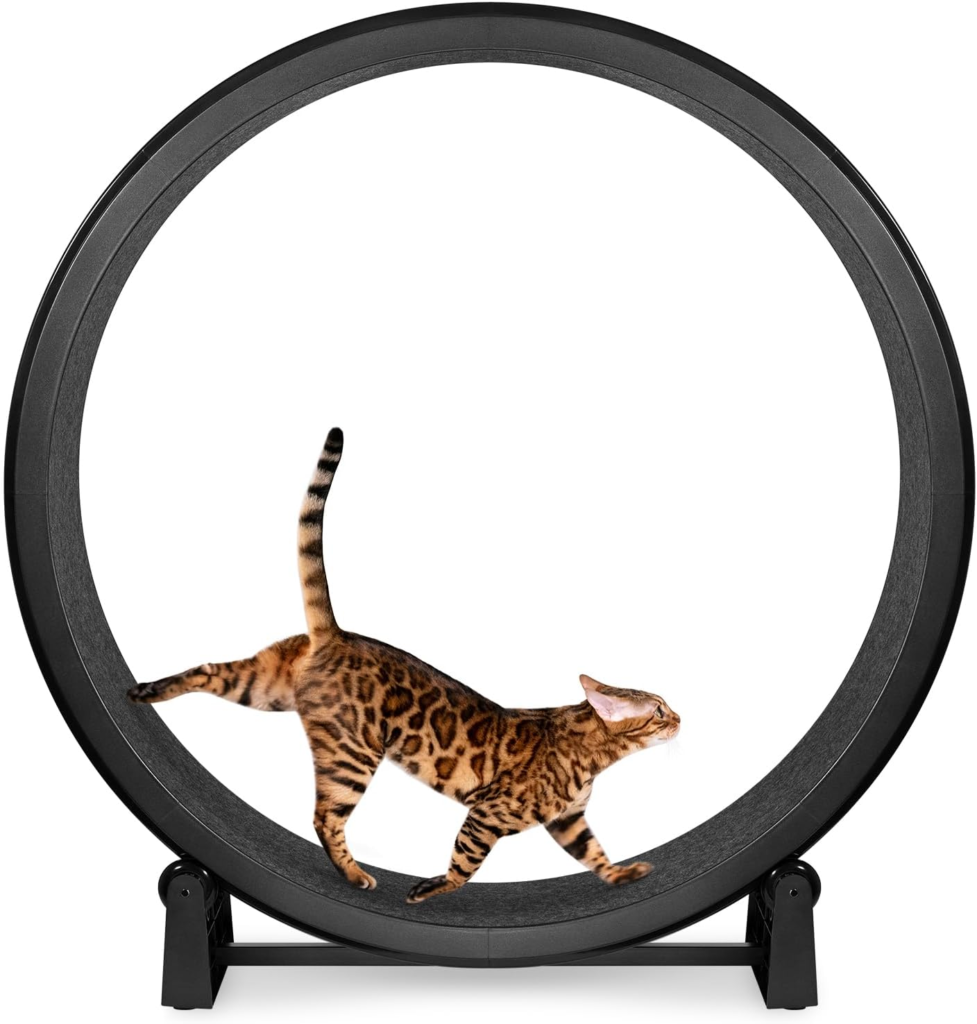
- Features: Made from lightweight recycled plastic, with a foam running surface for grip and comfort.
- Noise Level: One Fast Cat is designed with noise reduction in mind, using smooth ball bearings for quieter operation. However, some users report occasional squeaks, often resolved by routine maintenance or tightening screws.
- Customer Feedback: Generally praised for being quieter than many alternatives, but the sound can amplify on hard flooring.

- Features: A sturdy wooden construction with a smooth-running track and padded interior for noise reduction. Designed to cater to cats of all sizes.
- Noise Level: Known for its relatively quiet operation due to its solid build and sound-absorbing materials. Occasional squeaks may occur if the wheel isn’t lubricated regularly.
- Customer Feedback: Praised for its stable design and low noise output, making it ideal for apartments or shared spaces. Owners appreciate its minimal maintenance needs to keep noise at bay.
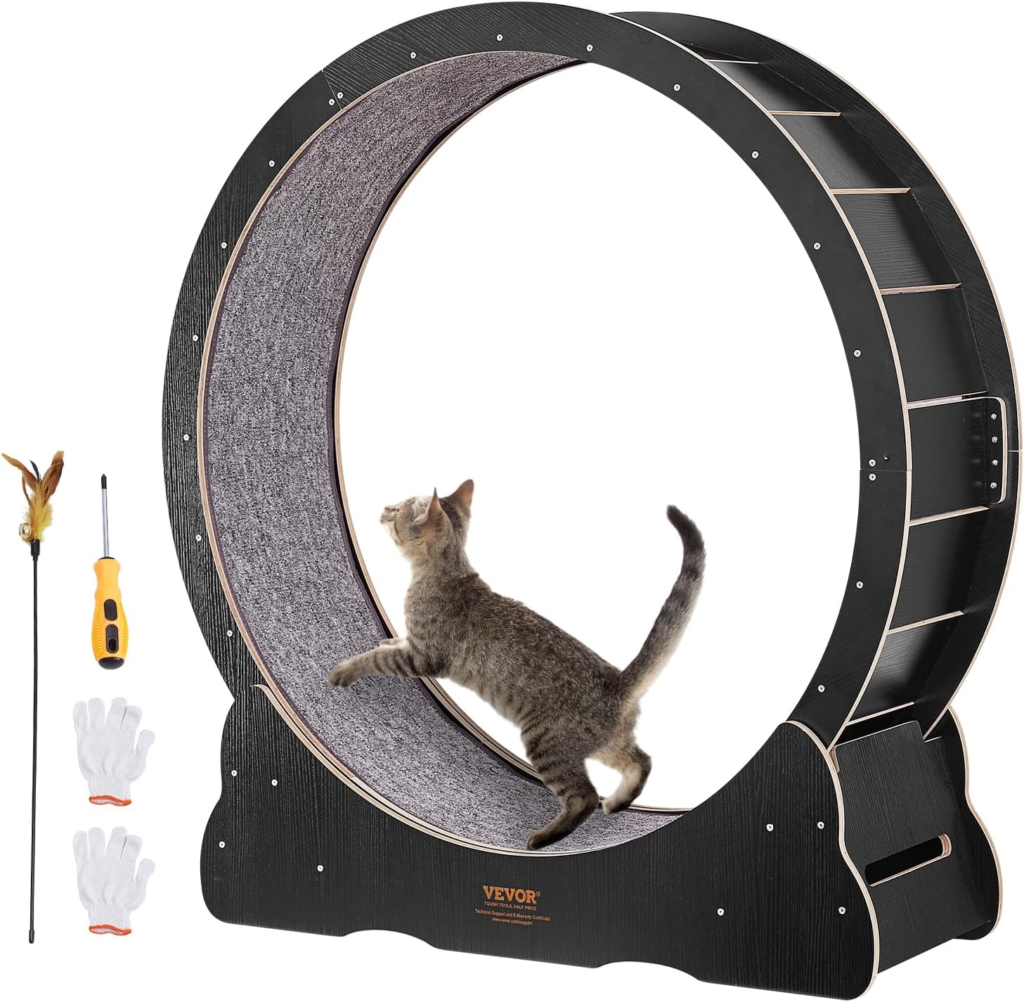
- Features: Made with durable plastic and designed for easy assembly, this wheel offers a wide running surface with an anti-slip track for safety.
- Noise Level: Slightly noisier than wooden models, especially on hard floors, but proper placement on a carpet or noise-dampening mat can help. Regular lubrication and maintenance reduce friction-related sounds.
- Customer Feedback: While some owners mention a faint whirring sound during fast running, most find it acceptable. Its affordability and lightweight design make it a popular choice, though it may require more attention to keep it running smoothly.
B. Customer Reviews and Noise Complaints
Here are some common themes from customer experiences with these wheels:
- Positive Feedback:
Customers appreciate the Homegroove Cat Wheel and One Fast Cat for their near-silent operation, especially in quieter households. The VEVOR Cat Wheel, while slightly noisier, is valued for its affordability and ease of setup. - Common Complaints:
- The VEVOR Cat Wheel may produce vibrations on hard floors if not placed on a padded surface.
- Both wheels can develop squeaks or rattles over time without proper maintenance, such as regular lubrication and tightening of screws.
By comparing popular brands and understanding their noise profiles, you can select a wheel that aligns with your household’s tolerance for sound. Up next, we’ll share practical tips to further minimize noise, ensuring a harmonious experience for both you and your feline friend.
V. Tips to Minimize Noise from a Cat Exercise Wheel
While many cat exercise wheels are designed with noise reduction in mind, there are practical steps you can take to further minimize sound. By focusing on proper setup, maintenance, and accessory use, you can create a quieter experience for your cat and your household.
A. Choosing the Right Wheel
- Prioritize Quality Materials:
Opt for wheels made of wood or high-quality plastic with ball-bearing mechanisms. These tend to be quieter than cheaper, friction-based alternatives. - Read Reviews for Noise Levels:
Before purchasing, check customer reviews for feedback on the wheel’s noise performance, especially during vigorous use.
B. Proper Placement
- Use a Noise-Reducing Surface:
Place the wheel on a carpet, rubber mat, or soundproof pad to reduce vibrations that can amplify on hard surfaces like tile or hardwood. - Avoid Walls and Corners:
Position the wheel slightly away from walls or corners to prevent echoing sounds. - Stable Ground:
Ensure the wheel is on a flat, even surface to prevent wobbling or shifting during use.
C. Maintenance and Care
- Lubricate Moving Parts:
Regularly apply a safe lubricant, such as silicone spray, to ball bearings or rotating mechanisms to keep the wheel running smoothly and silently. - Tighten Screws and Bolts:
Periodically check for loose screws or bolts that could cause rattling or squeaking. - Clean the Wheel:
Remove dust, fur, and debris from the running track and mechanisms to prevent buildup that can cause friction-related noise.
D. Using Noise-Reducing Accessories
- Rubber Pads or Mats:
Place rubber pads under the wheel’s base to absorb vibrations and reduce noise transmission to the floor. - Foam Inserts:
Some wheels come with or can be retrofitted with foam inserts or linings to dampen sound. - Anti-Slip Feet:
Add anti-slip feet or adhesive pads to the base of the wheel to improve stability and reduce noise caused by movement.
E. Training Your Cat for Noise Reduction
- Gradual Introduction:
Allow your cat to get comfortable with the wheel at slower speeds first. Rapid, high-speed running right away can cause more noise. - Encourage Controlled Use:
Play with your cat during specific times to minimize late-night wheel usage, which might be more disruptive.
F. Regular Inspections
- Monitor for Wear and Tear:
Check for signs of wear on the wheel’s track, bearings, or base. Replace any damaged parts promptly to prevent excessive noise. - Upgrade if Necessary:
If your current wheel remains noisy despite all efforts, consider upgrading to a higher-quality, noise-reducing model.
By implementing these tips, you can significantly reduce the noise from a cat exercise wheel, ensuring a more peaceful coexistence with your feline friend. In the next section, we’ll explore real-life experiences from cat owners and their solutions to noise-related challenges.
VI. Real-Life Experiences from Cat Owners
Hearing from other cat owners can provide valuable insights into what to expect when using a cat exercise wheel and how to address noise-related challenges. Below are some real-life experiences, both positive and negative, shared by pet owners who have incorporated these wheels into their homes.
A. Success Stories: Quiet Wheels and Happy Cats
- Anna from New York:
“I bought the Zhilishu wooden cat wheel, and it’s been a game-changer! My Bengal cat absolutely loves it, and the noise is barely noticeable. I placed it on a thick rug to prevent vibrations, and it works like a charm. Even when my cat runs at full speed, I only hear a soft hum.” - James in Chicago:
“I was skeptical about getting a wheel because I live in an apartment with thin walls. I chose the One Fast Cat wheel, and while it was a bit noisy at first, lubricating the bearings every few weeks made a huge difference. Now, it’s quiet enough that my neighbors don’t even know it’s there!” - Sophia in Austin:
“I opted for the MewooFun wheel because it promised low noise, and it delivered. The foam padding on the track absorbs a lot of the sound. My cat uses it every evening, and it’s barely audible over the TV.”
B. Challenges and Solutions
- Mark from Seattle:
“I noticed the plastic wheel I got started squeaking after a month. At first, I thought I had to replace it, but then I tightened a few screws and added some silicone spray to the bearings. Problem solved—it’s much quieter now!” - Lisa in Los Angeles:
“My cat is super energetic, and when he jumps on the wheel, it makes a loud thud. I fixed this by adding a thick rubber mat underneath the wheel, which not only reduced the noise but also prevented it from sliding.” - Emily from Denver:
“I live in a small apartment with hardwood floors, and the vibrations were driving me crazy. Placing the wheel on a memory foam mat worked wonders. Now it’s almost silent, even during my cat’s late-night zoomies!”
C. What Cat Owners Wish They Knew Beforehand
- Test Runs Matter: Many cat owners recommend testing the wheel in-store, if possible, or purchasing from a brand with a generous return policy.
- Maintenance is Key: Regular cleaning and lubrication are often necessary to keep noise at bay, something many didn’t realize when they first purchased the wheel.
- Placement Makes a Difference: Some owners underestimated how much noise is amplified by certain flooring types, learning only after trial and error.
D. Expert Advice from Cat Enthusiasts
Some experienced cat owners have shared tips that go beyond just noise reduction:
- Introduce the Wheel Gradually: Cats that are unsure of the wheel at first may paw or scratch at it, creating additional noise. Gentle encouragement and training can help them use it properly.
- Time Usage: A few owners recommend limiting access to the wheel at night, especially in small apartments, to avoid disturbances during sleep.
Real-life experiences highlight that while noise can be a concern, it’s often manageable with a few adjustments. With the right preparation and ongoing care, cat owners have successfully balanced the benefits of an exercise wheel with maintaining peace in their homes. In the next section, we’ll weigh the pros and cons of these wheels, focusing on noise considerations.
VII. Pros and Cons of Cat Exercise Wheels (Considering Noise)
Cat exercise wheels offer significant benefits, but they also come with certain drawbacks—especially when it comes to noise. Understanding these pros and cons can help you determine whether a wheel is the right fit for your household.
A. Pros
- Improved Cat Health and Well-Being
- Regular use promotes physical fitness, helping prevent obesity and related health issues.
- Encourages natural behaviors, such as running and chasing, providing mental stimulation.
- Quiet Options are Available
- Many modern cat wheels are designed with noise reduction in mind, using materials like wood and ball-bearing mechanisms to ensure smooth, quiet operation.
- Accessories such as rubber mats or soundproof pads can further reduce noise levels.
- Reduced Behavioral Issues
- A cat with an outlet for its energy is less likely to engage in destructive behaviors, such as scratching furniture or excessive vocalizing.
- Customizable Noise Management
- Owners can minimize noise by choosing a wheel suited to their flooring, properly maintaining the wheel, and ensuring secure placement.
B. Cons
- Noise Potential During Use
- Wheels can produce sounds such as squeaking, vibrations, or thudding, particularly during high-speed activity.
- Noise can amplify in apartments or shared spaces with hard floors or thin walls.
- Maintenance Requirements
- To maintain quiet operation, regular maintenance is necessary, such as lubricating bearings and tightening screws. Without upkeep, wheels may become noisier over time.
- Initial Cost of Quiet Wheels
- Higher-quality, noise-reducing wheels often come with a premium price tag. Budget options may be noisier, requiring additional investments in noise-dampening accessories.
- Not All Cats Take to the Wheel
- Some cats may not use the wheel despite encouragement, making any noise concerns irrelevant but leaving owners with an unused item.
C. Balancing the Pros and Cons
While noise is a valid concern, the advantages of a cat exercise wheel—such as improved health and reduced destructive behaviors—often outweigh the drawbacks. With careful product selection, proper setup, and consistent maintenance, many cat owners find that noise can be managed effectively.
In the next section, we’ll summarize the key takeaways and provide final advice on managing noise while keeping your cat happy and active.
VIII. Conclusion
Cat exercise wheels are an excellent tool for keeping indoor cats active, healthy, and mentally stimulated. However, noise is a common concern that can affect your decision when choosing the right wheel for your home. The level of noise depends on several factors, including the wheel’s material, design, placement, and maintenance. While some wheels produce minimal sound, others may require extra effort to keep noise at bay.
The good news is that most noise-related issues can be managed effectively. Choosing a high-quality wheel, placing it on noise-dampening surfaces, and performing regular maintenance can significantly reduce disturbances. Additionally, many brands offer innovative designs with noise-reducing features, making it easier than ever to find a wheel that balances your cat’s exercise needs with your household’s peace and quiet.
Ultimately, investing time in selecting the right wheel and taking a proactive approach to noise management will ensure a positive experience for both you and your feline companion. With the right setup, you can enjoy the benefits of a happy, healthy cat without compromising the tranquility of your home.
IX. FAQs
1. Are cat exercise wheels noisy?
Cat exercise wheels can produce some noise, but the level depends on the wheel’s design, material, and maintenance. High-quality wheels with ball-bearing mechanisms are typically quieter, while poorly maintained or low-quality wheels may squeak or vibrate. Proper placement and regular upkeep can minimize noise significantly.
2. Which cat exercise wheel is the quietest?
Wheels made from wood or high-quality plastic with advanced engineering tend to be the quietest. Brands like Zhilishu and Cat in Motion are often praised for their near-silent operation due to their sturdy build and smooth rotation mechanisms.
3. How can I reduce the noise from my cat exercise wheel?
To reduce noise:
- Place the wheel on a rubber mat or carpet to absorb vibrations.
- Lubricate the wheel’s moving parts regularly.
- Tighten screws and bolts to prevent rattling.
- Clean the wheel frequently to remove dirt and debris that could cause friction.
4. Do all cats use exercise wheels?
Not all cats will take to an exercise wheel immediately. Some may need encouragement or training to get comfortable with it. Treats, toys, and positive reinforcement can help cats learn to use the wheel over time.
5. Will a cat exercise wheel disturb my neighbors?
In apartments or shared living spaces, noise from a cat wheel may carry through walls or floors, especially if placed on hard surfaces. Using a noise-dampening mat and selecting a quieter wheel can reduce disturbances.
6. How can I tell if a wheel will be noisy before buying it?
Check product reviews and customer feedback, focusing on comments about noise levels. Look for wheels advertised as having noise-reducing features, such as ball bearings or padded tracks. If possible, test the wheel in-store or purchase from a retailer with a flexible return policy.
7. What should I do if my wheel starts making noise?
If your cat exercise wheel becomes noisy:
- Inspect it for loose screws or bolts and tighten them.
- Clean the track and moving parts to remove dirt and debris.
- Apply a safe lubricant, like silicone spray, to reduce friction.
8. Is it worth investing in a quieter, more expensive wheel?
If noise is a concern, investing in a high-quality wheel with noise-reducing features is worthwhile. While the initial cost may be higher, these wheels are more durable, quieter, and often require less maintenance, making them a better long-term choice.
These FAQs address common questions about cat exercise wheels and their noise levels, helping you make an informed decision for your feline friend and your home environment.


